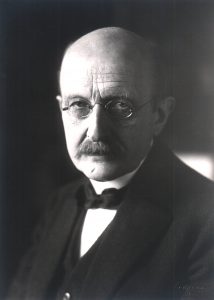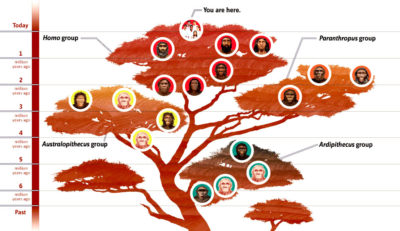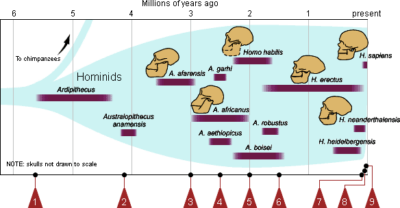 The “Insights into hominid evolution from the gorilla genome sequence” report, published by the British journal Nature this last week, stands as a historical milestone in the study of human origins, sequencing the gorilla genome.
The “Insights into hominid evolution from the gorilla genome sequence” report, published by the British journal Nature this last week, stands as a historical milestone in the study of human origins, sequencing the gorilla genome.
Aylwyn Scally (pictured right below) at the Wellcome Trust Sanger Institute led the research team to complete the gorilla genome sequence project, the last genus of the living great apes to have its genome decoded.
The use of gorilla genome sequences, Scally explains –
“Will promote a deeper understanding of great ape biology and evolution.”
Scientists now have the technology available to examine the gorilla genomes and compare it to the genome of the other living great apes; the human, chimpanzee, and orangutan genomes. The goal of the genomic information is to validate the evolutionary relationships of the hominins scientifically.
Ajit Varki of the University of California, San Diego, and specialist advisor to the Human Gene Nomenclature Committee who was not involved in the study, provided a generic endorsement to the findings – 
“This information is, of course, of great interest to many investigators.”
National Public Radio (NPR), commenting on the Wellcome discovery, provided a similar endorsement as reflected in the title their article –
“Gorilla Genome Sheds Light On Human Evolution”
Study Results
From the 11,000 genes studied, while humans and chimpanzees are genetically close, the Wellcome team found areas of the genome where this is not the case. For example, 15% of the human genome is closer to the gorilla genome than it is to a chimpanzee, and 15% of the chimpanzee genome is closer to the gorilla than the human.
Overall, the human genome is 1.37% different from the chimps, 1.75% different from the gorillas, and 3.4% different from the orangutans.
The team discovered, surprisingly, that “In 30% of the [gorilla] genome, the gorilla is closer to human or chimpanzee than the latter are to each other.” According to Scally –
“Some of our functional biology is more gorilla-like than chimplike.”
The location of genes on the chromosome between the species did not follow a pattern of “slight successive” changes during speciation. The distances were unpredictable. The team reports –
“The genealogy relating human (H), chimpanzee (C), and gorilla (G) varies between loci across the genome.”
Congruence in the rate of genetic mutations with an associated rate of speciation proved to be unpredictable. “The inability to observe past mutation rates means that the timing of events from genetic data remains uncertain,” the team reported. Scally summarizes the significant issues discovered –
“Indeed, the relationship between molecular and fossil evidence has remained difficult to resolve despite the accumulation of genetic data.”
Rather than successive patterns of speciation events growing a tree of life, as the evidence demonstrates –
“The prevailing pattern of ape evolution has been one of fragmentation and extinction.”
At best, the findings provide a platform for future studies, as the team notes –
“Here, we provide a reference assembly and initial analysis of the gorilla genome sequence, establishing a foundation for the further study of great ape evolution and genetics.”
Darwin’s dilemma intensifies. As for Scally, though –
“Better resolution may come from further integrated analysis of fossil and genetic evidence.”
The Challenge
D ave Mosher, writing for the National Geographic in the article entitled “Gorillas More Related to People Than Thought,“ noted the problem with any hominin tree of life scheme –
ave Mosher, writing for the National Geographic in the article entitled “Gorillas More Related to People Than Thought,“ noted the problem with any hominin tree of life scheme –
“Another surprising result is that part of the gorilla genome is at odds with the current structure of the great ape evolutionary tree. For example, instead of gorillas being most similar to chimps and then humans in that portion of the DNA, the branches flip to humans being most similar to gorillas and then chimps.”
The genomic revolution continues to undermine the theory of evolution by means of natural selection. Italian geneticist, Giuseppe Sermonti noted in 1999 –
“One spur to research on mutations was the hope that an accumulation of these might lead to a new species. But this never happened… Displaying the table of the genetic code as though it demonstrated the unveiling of life’s interlocking puzzle is a mistaken enterprise.”
In the words of Sermonti, “Science has taken on the great wager… and lost.”
Genesis
While the gorilla genome project did not provide “a deeper understanding of great ape biology and evolution,” the evidence is compatible with the Genesis account written by Moses.
Max Planck, a German theoretical physicist, was awarded the Nobel Prize in Physics in 1918 for proposing the theory of quantum mechanics. In the words of Plank during the Scientific Revolution –
“Yet in the whole of the universe there is no force that is either intelligent or eternal, and we must, therefore, assume that behind this force there is a conscious, intelligent Mind or Spirit. This is the very origin of all matter.”
Refer to the Glossary for the definition of terms and to Understanding Evolution to gain insights into understanding evolution.
2020 Update
WIKIPEDIA – Ape
While including information from the Chimpanzee genome project, the Human genome project, and the Neanderthal genome project, there is no mention of the Gorilla genome project.
The page, including eight different trees of life schemes, concludes with the following statement –
“The many affinities between humans and other primates – and especially the “great apes” – made it clear that the distinction made no scientific sense.”
Evolution 101 – Human Evolution
While there is no mention of Gorillas or the Gorilla genome project, the page mentions chimpanzees, noting –
“Before 5 mya: In Africa, our ancestral lineage and the chimpanzee lineage split.”
A tree of life graphic for hominins is pictured right
Smithsonian Institute – Human Evolution Genetics
While there is no mention of Scally’s study, the page explains –
“The DNA difference with gorillas, another of the African apes, is about 1.6%. Most importantly, chimpanzees, bonobos, and humans all show this same amount of difference from gorillas… No matter how the calculation is done, the big point still holds: humans, chimpanzees, and bonobos are more closely related to one another than either is to gorillas or any other primate.”
A primate tree of life graph groups the Chimpanzees and Bonobos are closer to Humans than Gorillas. Significantly, the identification of common ancestry for the Prosimians, Monkeys, or Apes continues to be the lost “great wager.”
A tree of life graphic for hominins is pictured right
Harvard University – Department of Human Evolutionary Biology
Their website does not have a “tree of life” diagram that includes Homo sapiens.


